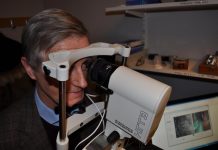January 2007 - The millions of Americans afflicted with Type 1 and 2 Diabetes face many potential complications, including: heart and kidney disease; nerve damage and stroke; foot and skin problems; and gastrointestinal disorders and hypoglycemia.
Another major complication, affecting up to 24,000 new people per year, is permanent blindness due to diabetic retinopathy, a degenerative disease of the retina (the sensitive area at the back of the eye). Overall, diabetic retinopathy affects 5.3 million Americans 18 and older.
But there�s hope. The American Academy of Ophthalmology wants Americans to know that even though diabetes is the leading cause of new cases of blindness, vision loss can be prevented if the disease is diagnosed and treated in time.
"Only 50 to 60 percent of those with diabetes get the recommended yearly eye examinations," said Jose S. Pulido, MD, Academy clinical correspondent and professor of ophthalmology at the Mayo Clinic in Rochester, Minn. "Studies show effective treatments, including an annual dilated eye exam, can reduce severe vision loss by up to 94 percent."
According to the American Diabetes Association, there are 20.8 million people in the United States, or 7 percent of the population, who have diabetes. While an estimated 14.6 million have been diagnosed, 6.2 million people (or nearly one-third) are unaware that they have the disease.
Continue Reading Below ↓↓↓
"This is a tragedy waiting to happen because people who are unaware they have the disease are at a substantially greater risk for vision loss and other complications," said Dr. Pulido. "The first step in preventing complications is finding out if you have the disease. It�s important for all healthy adults over the age of 45 to have a blood sugar test once every three years."
Dr. Pulido said that the longer a person has diabetes, the greater the risk for developing diabetic retinopathy.
"Diabetic retinopathy does not only affect people who have had diabetes for many years, it can also appear within the first year or two after the onset of the disease," he said. "For some people, diabetic retinopathy is one of the first signs of the disease."
Anatomy of Diabetic Retinopathy
High blood sugar levels weaken blood vessels in the eye's retina, causing them to leak blood or fluid. This causes the retina to swell and can lead to vision loss.
Blood sugar fluctuations can also promote growth of new, fragile blood vessels on the retina, which can easily break and leak blood into the vitreous (the clear, jelly-like substance that fills the center of the eye). This can blur vision and lead to permanent blindness.
In its earliest stages diabetic retinopathy may not affect vision, but over time it can cause vision loss and even blindness in both eyes.
What are the Signs of Diabetic Retinopathy?
"Fluctuations in blood sugar levels can temporarily affect vision, so it's sometimes difficult to know if a serious eye problem is developing," said Dr. Pulido. "That's one of the reasons strict control of your blood sugar is so important. If you notice a vision change in one eye, a change that lasts more than a day or two, or changes not associated with fluctuations in blood sugar, contact your Eye M.D. immediately."
Other ways to reduce the risk of eye disease:
Continue Reading Below ↓↓↓
- Keep your blood glucose level as close to normal as possible through diet, exercise and, if needed, medication
- Keep your blood pressure under control
- Keep your cholesterol levels low
- Don�t smoke
- Make sure your hemoglobin A1c levels (a measure of good blood sugar control) are measured at least every four months and are less than 7.1.
Diabetic Retinopathy: A New Hope
Although incurable, diabetic retinopathy can be treated to retard its onset and progression. There�s hope for the development of new pharmacological treatments that would not require invasive laser surgery. These treatments might even restore the vision that the disease destroys.
These potential treatments signal a move away from laser photocoagulation to drugs injected into the eye, as well as oral treatments.
Many of these drugs block the pathways that contribute to the vascular disruptions that characterize diabetic retinopathy. Specifically, they aim to inhibit the growth of new blood vessels or the activity of proteins in the nerve cells of the retina.
These treatments hold promise of intervention at earlier, non-sight-threatening stages, but they will require renewed emphasis on early detection. The newest and best treatments will be most effective only when the underlying disease�diabetes�is under control.
Free Eye Exams for Seniors
EyeCare America, a public service foundation of the American Academy of Ophthalmology, encourages diabetes patients, age 65 and older, to take advantage of its Diabetes EyeCare Program. This year-round program offers eye exams and up to one year of care at no out-of-pocket cost to qualified patients who are without an ophthalmologist.
To see if you, a loved one or a friend, is eligible to receive a referral to one of EyeCare America's 7,300 volunteer ophthalmologists, call 1-800-272-EYES (3937). The EyeCare America help lines are open 24 hours a day, every day, year round. More information on EyeCare America can be found here.
Source: American Academy of Ophthalmology (AAO) / Newswise









